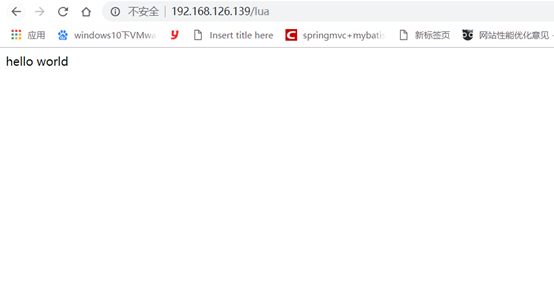这篇文章是一个多月前写的,当时之所以搭建这个是为了最大程度上发挥Nginx的高并发效率(主要是结合lua脚本),参考的话,主要参考张开涛先生写的跟开涛学Nginx+lua系列文章,地址为:https://jinnianshilongnian.iteye.com/blog/2190344
当时本人按照张开涛写的一步一步搭建,当然了也发现一些小问题,所以在此将其发表出去,另外强调一点,开发人员无论是平时编写代码或者是调研新技术或者实践,最好也写写文档总结一下。
我写文档的主要目的,一来让自己思路更加清晰,二来为博文积累素材,三来这是一个秘密。
下面进入正题吧
1.创建目录/usr/servers
mkdir -p /usr/servers
cd /usr/servers/
2.安装依赖(不同的系统环境需要以不同的方式安装依赖,具体可以参考该地址: //openresty.org/#Installation)
apt-get install libreadline-dev libncurses5-dev libpcre3-dev libssl-dev perl
3.下载ngx_openresty-1.7.7.2.tar.gz并解压
wget http://openresty.org/download/ngx_openresty-1.7.7.2.tar.gz
tar -xzvf ngx_openresty-1.7.7.2.tar.gz
ngx_openresty-1.7.7.2/bundle目录里存放着nginx核心和很多第三方模块,比如有我们需要的Lua和LuaJIT
4.安装LuaJIT
cd bundle/LuaJIT-2.1-20150120/
make clean && make && make install
ln -sf luajit-2.1.0-alpha /usr/local/bin/luajit
5.下载ngx_cache_purge模块,该模块用于清理nginx缓存
cd /usr/servers/ngx_openresty-1.7.7.2/bundle
wget https://github.com/FRiCKLE/ngx_cache_purge/archive/2.3.tar.gz
tar -xvf 2.3.tar.gz
6.下载nginx_upstream_check_module模块,该模块用于ustream健康检查
cd /usr/servers/ngx_openresty-1.7.7.2/bundle
wget https://github.com/yaoweibin/nginx_upstream_check_module/archive/v0.3.0.tar.gz
tar -xvf v0.3.0.tar.gz
7.安装ngx_openresty
cd /usr/servers/ngx_openresty-1.7.7.2
./configure --prefix=/usr/servers --with-http_realip_module --with-pcre --with-luajit --add-module=./bundle/ngx_cache_purge-2.3/ --add-module=./bundle/nginx_upstream_check_module-0.3.0/ -j2
make && make install
--with*** 安装一些内置/集成的模块
--with-http_realip_module 取用户真实ip模块
-with-pcre Perl兼容的达式模块
--with-luajit 集成luajit模块
--add-module 添加自定义的第三方模块,如此次的ngx_che_purge
8.启动nginx
/usr/servers/nginx/sbin/nginx
9.配置nginx+lua开发环境
(1) 编辑nginx.conf配置文件
vim /usr/servers/nginx/conf/nginx.conf
(2)在http部分添加如下配置
#lua模块路径,多个之间”;”分隔,其中”;;”表示默认搜索路径,默认到/usr/servers/nginx下找
lua_package_path "/usr/servers/lualib/?.lua;;"; #lua 模块
lua_package_cpath "/usr/servers/lualib/?.so;;"; #c模块

其实之所以编写example.conf,是考虑Nginx+Lua开发文件会越来越多,如果全部挤在nginx文件下的话,不利于管理和维护。
/usr/example/example.conf配置文件如下 :
server {
listen 80;
server_name _;
location /lua {
default_type 'text/html';
lua_code_cache off;
content_by_lua_file /usr/example/lua/test.lua;
}
}
test.lua内容如下:
ngx.say("hello world");
重启Nginx在浏览器输入:http://IP/lua,出现hello world表示成功
例如:

最后完整的nginx.conf文件如下:
#user nobody;
worker_processes 2;
error_log logs/error.log;
#error_log logs/error.log notice;
#error_log logs/error.log info;
#pid logs/nginx.pid;
events {
worker_connections 1024;
}
http {
include mime.types;
default_type application/octet-stream;
#lua模块路径,多个之间”;”分隔,其中”;;”表示默认搜索路径,默认到/usr/servers/nginx下找
lua_package_path "/usr/servers/lualib/?.lua;;"; #lua 模块
lua_package_cpath "/usr/servers/lualib/?.so;;"; #c模块
include /usr/example/example.conf;
#log_format main '$remote_addr - $remote_user [$time_local] "$request" '
# '$status $body_bytes_sent "$http_referer" '
# '"$http_user_agent" "$http_x_forwarded_for"';
#access_log logs/access.log main;
sendfile on;
#tcp_nopush on;
#keepalive_timeout 0;
keepalive_timeout 65;
#gzip on;
server {
listen 80;
server_name localhost;
#charset koi8-r;
#access_log logs/host.access.log main;
location / {
root html;
index index.html index.htm;
}
#error_page 404 /404.html;
# redirect server error pages to the static page /50x.html
#
error_page 500 502 503 504 /50x.html;
location = /50x.html {
root html;
}
# proxy the PHP scripts to Apache listening on 127.0.0.1:80
#
#location ~ .php$ {
# proxy_pass http://127.0.0.1;
#}